The 'Kylin' clock 2nd half 18th century, mounts: c.1700-1822
Porcelain, gilt bronze | 111.7 x 81.3 x 36.9 cm (whole object) | RCIN 2867



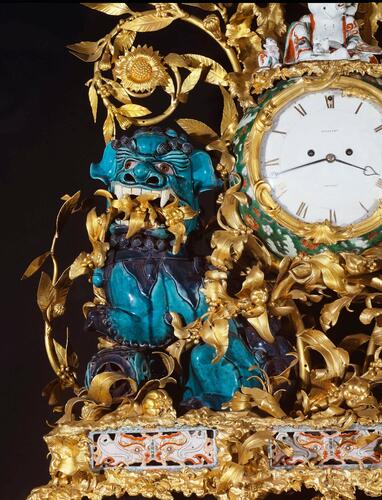

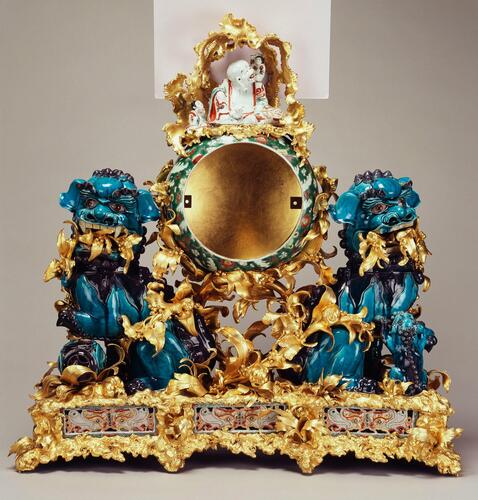

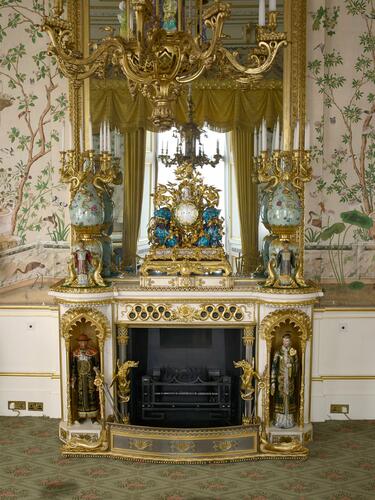

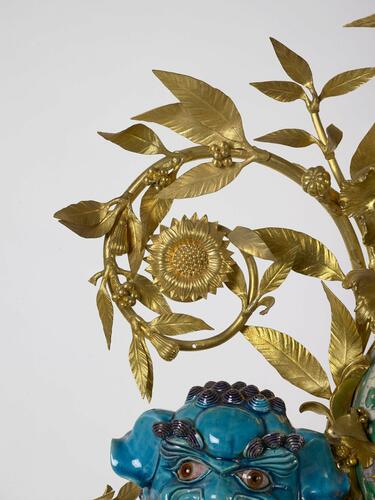
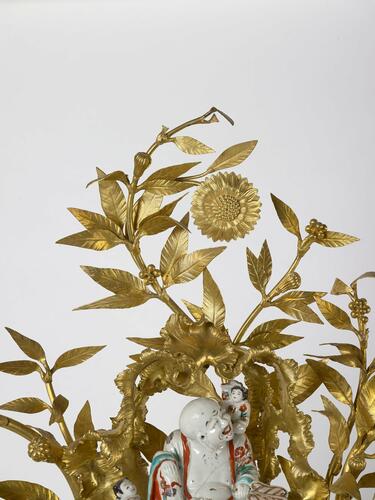
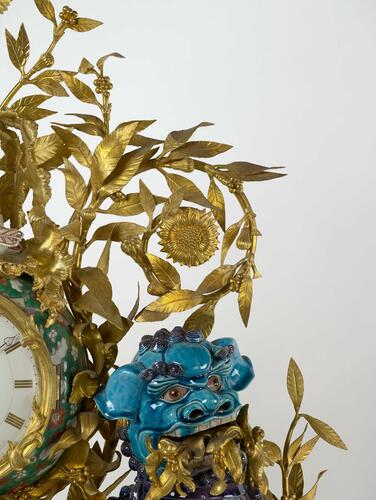
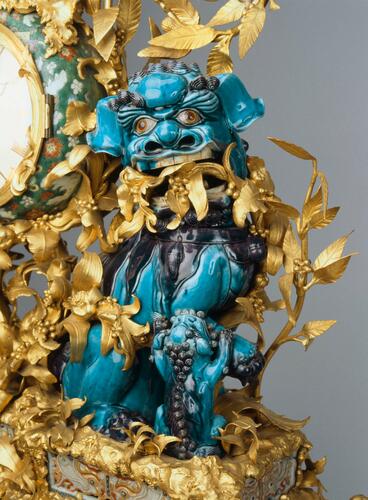


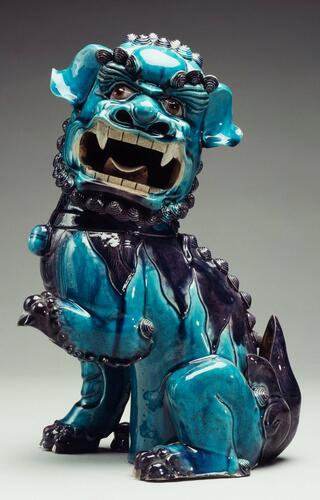
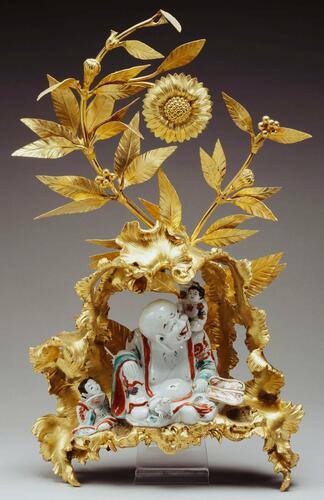
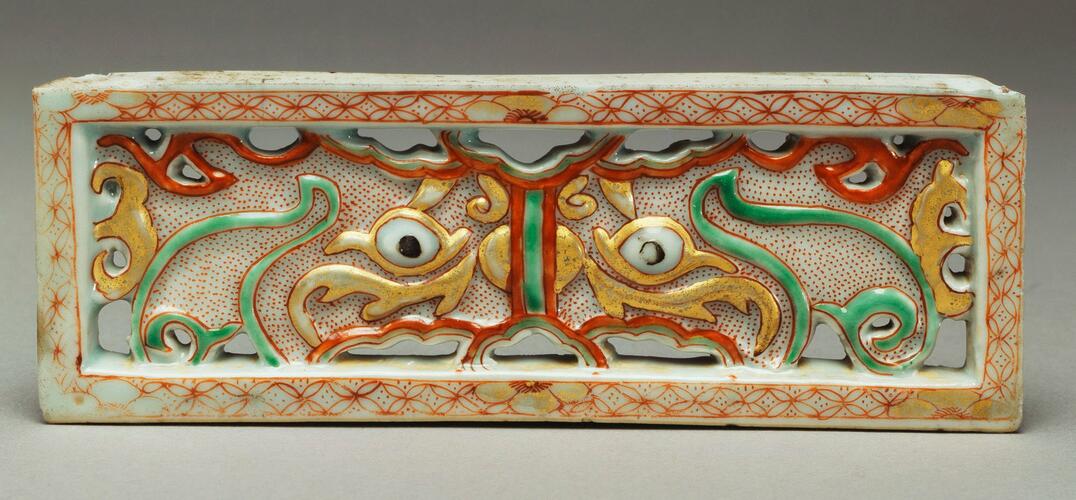
-
The misnamed ‘kylins’ of the time-honoured title of this clock are the pair of squatting lions of turquoise- and purple-glazed porcelain from the first half of the eighteenth century which flank the clock case, their open jaws displaying their tongues and teeth, the lion on the left having an embroidered ball under his paw, and his mate on the right, a cub; the manes and other details coloured purple. The clock between them, later replaced by Vulliamy, was mounted in France in an inverted bowl of mid-seventeenth century Chinese porcelain, cut from the shoulder of a jar such as RCIN 39243.1-2, decorated in green, yellow and red, with waves and flowers. Above is a small, late seventeenth-century Japanese porcelain figure group in Kakiemon-style enamels, comprising a seated Hotei holding a fan, with two children. Wreathed around the lions and the clock-case are several branches which issue fig like fruit, berries and leaves; five such branches, including the central branch with a sunflower, the two either side of Hotei and the two branches with leaves at each side, were added by Samuel Parker, while above, surrounding Hotei are several branches issuing leaves, berries, poppy pods(?) and sunflowers. The Hotei group is held within a pierced rockwork ‘grotto’. The dial bezel is wreathed with foliage and C-scrolls. The entire assemblage is set on a base composed of eight early eighteenth-century rectangular Chinese famille verte porcelain panels painted with antique masks, apparently cut from the sides of a stand or box, framed within elaborate rocky and floral borders of gilt bronze with eight feet. A separate gilt-bronze base, supported on acanthus scrollwork and central cartouche with floral spray, was created in France in the eighteenth century; and beneath this is a further white marble band gilt-bronze-mounted plinth of neo-classical inspiration, supplied by Henry Westmacott, with mounts made by Parker, together with a brass-framed glass case. An eight-day rack striking clock on a bell with a fusee movement and recoil escapement. The face of enamel with the twelve hours represented in gold Roman figures; a pair of pierced blued steel spade hands. Benjamin Lewis Vulliamy supplied a new movement in 1821.
This extravaganza was probably purchased in France about 1820, with the furnishing of the Royal Pavilion, Brighton, in mind. On 5 January 1821, the royal clockmaker, B.L. Vulliamy, invoiced for a new clock into ‘a very old french Case decorated with old oriental Chinese dragons &c and ormoulu. £31.10.-’ (National Archives LC 11/30). Featuring as the centrepiece of a garniture de cheminée in the Saloon, as redesigned by Robert Jones, it was further embellished to his designs by Samuel Parker (invoice 19 October 1823: ‘Additional leaves to enrich the Ornaments on the Clock highly chased and gilt … £17.-.-.’, National Archives LC 11/41), although his total charge amounted to £250. So that the ornaments of clock and mantelpiece would correspond more closely, the gilt-bronze lotus and sunflower motifs were added, being supported on branches which are entwined round the lions and frame the clock cylinder (National Archives LC 11/41, bill of Robert Jones, 27 June 1823). Another clock which combines oriental porcelain with similar French mounts and retains its old movement by Pierre Le Roy (?1717-85) is in the Residenz museum, Munich, but the maker (or 'compiler') of neither piece is known. The marble part of the plinth was supplied by Henry Westmacott, and was ‘wrought with Templet - with sinkings for Or Moulu for the clock’ (National Archives LC 11/38, bill of Henry Westmacott, 5 January 1823), and fitted with ‘ormolu decorations to Mr Jones Design’, supplied by Samuel Parker (National Archives LC 11/38, bill of Samuel Parker, quarter ending 5 January 1823).
Benjamin Lewis Vulliamy supplied a new movement in 1821 ‘One of the best 8-day Spring Clocks to regulate in the dial with a rise and fall Chains ebony pendulum and a very fine hard enamel dial plate painted in gold and fitting it into a very old French Case decorated with old oriental Chinese Dragons &c & ormolu £31 10s.
A new raised back door for the Case to give room for the Bell repairing the Body part of the Case which holds the Clock which was much damaged and making it fit to carry the Clock & fixing it to the ring of the case £2 12s. 6d. A new Glass to the front door 12s.’
Vulliamy number 742
Catalogue entry from Royal Treasures, A Golden Jubilee Celebration, London 2002 and adapted from Chinese and Japanese Works of Art in the Collection of Her Majesty The Queen, Volume II.Provenance
George IV, c.1820. Recorded in the Saloon at the Royal Pavilion, Brighton (1829B, p. 15), and noted there in the Brighton Pavilion Inventory of Clocks and China 1828 (p. 3): ‘A magnificent Clock by Vulliamy, in a richly enamelled china case, surmounted by a group of enamelled Chinese Figures, sitting under an ormolu scroll Canopy, supported by two large turquoise blue Kylins, having dark blue ornaments, on a rock plinth, with pierced enamelled China panels, the whole highly decorated with a profusion of ormolu foliage of flowers, & placed on a massive scroll ormolu base, with an additional statuary marble plinth, bordered and panelled with ormolu pateras, arrows and flowers - 12 ormolu feet; Extreme height 3 feet 9 inches [114.3 cm] - large plate glass shade in brass mouldings and Stand. No. 742’; transferred to Windsor Castle in 1847 (1829A, p. 1); recorded in the Chinese Luncheon Room, Buckingham Palace, in 1914 (1829B, p. 15).
It is depicted in situ in the Saloon in Nash 1826. At Buckingham Palace it was installed in the Chinese Luncheon Room and may be seen in J. Roberts’ 1850 watercolour of that room, placed between the pair of mounted Arita porcelain candelabra, (RCIN 203.1−2).The clock was consigned to Windsor following Queen Victoria's decision to sell the Royal Pavilion in 1846. It comprises items 4 and 5 in a 'List of Clocks, Shades Etc packed at the Pavilion Brighton 1846. Delivered by Mr. Tupper to Windsor Castle. 6 Jan 1847' and described as 'A Clock in a richly enamalled China case supprted by two large turkois blue Kylings, and highly decorated with ormolu foliage & flowers with a massive scroll ormolu base and marble plinth'. Three years later it was recorded in the Pavilion Breakfast Room at Buckingham Palace.
Exhibited in Royal Treasures: A Golden Jubilee Celebration, The Queen’s Gallery, London, 2002. -
Creator(s)
(porcelain manufacturer)(clockmaker (movement))(metalworker)(metalworker)(nationality)(nationality)(nationality)Acquirer(s)
-
Medium and techniques
Porcelain, gilt bronze
Measurements
111.7 x 81.3 x 36.9 cm (whole object)
Other number(s)
Alternative title(s)
Mantel clock








